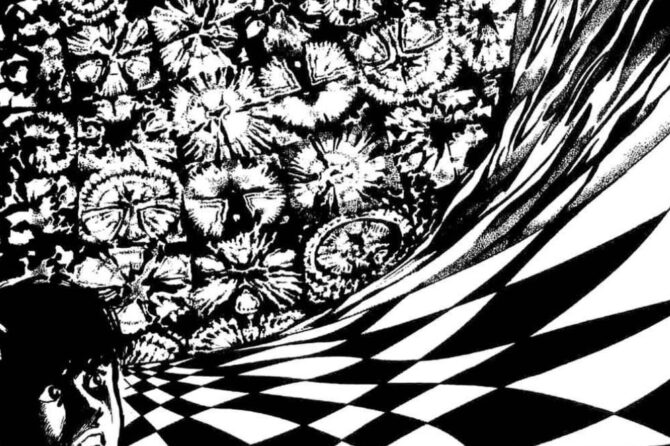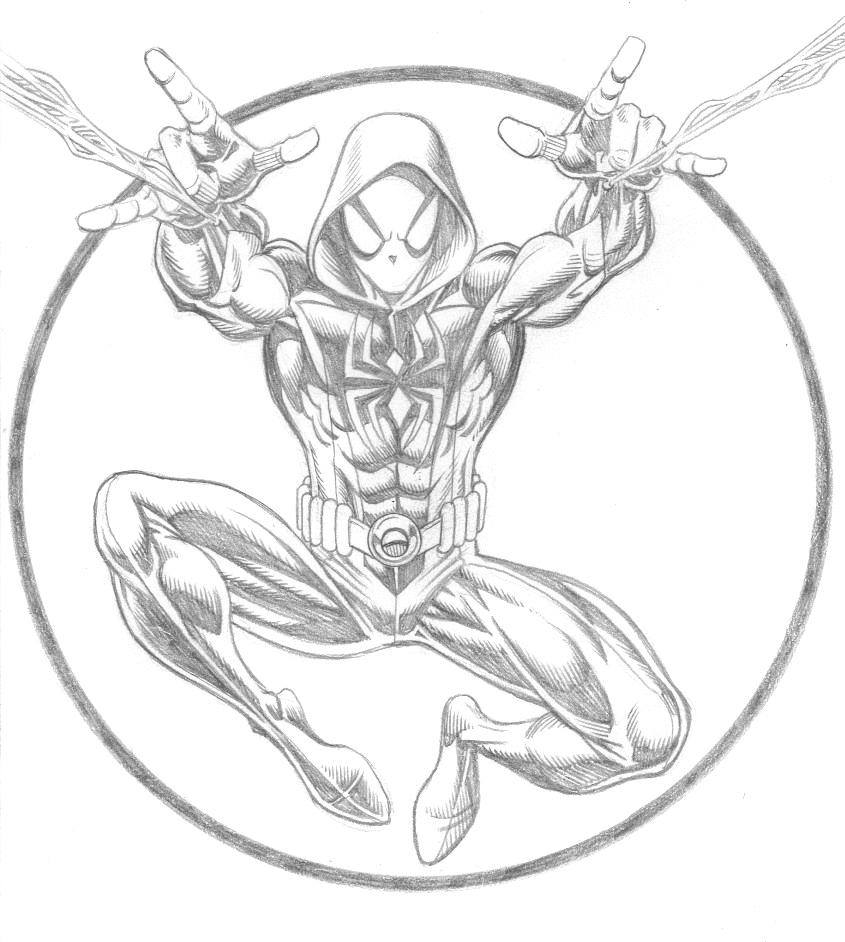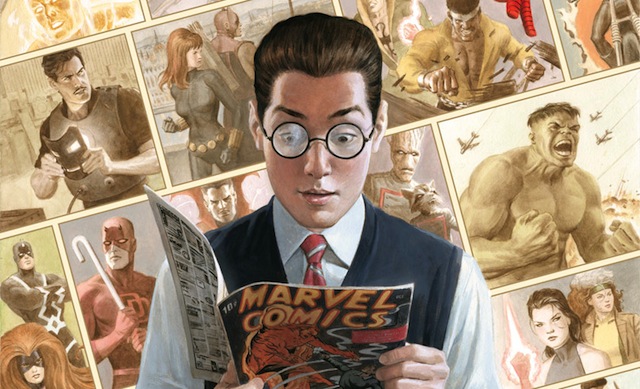With the recent release of Friendly Neighborhood Spider-Man #1, it’s a good idea to look at how spider-satellites have been done in the past. Last time, we looked at what these books need in order to be successful, with one of the most important factors being the hook: something that makes this series unique from the other monthly superhero titles, even those starring the wallcrawler.
The initial identities were simpler. Marvel Team-Up paired Spider-Man with other heroes in the Marvel Universe. Initially, it was supposed to just be him and the Human Torch, but that was abandoned by the fourth issue. Because the guest-starr competed with Spidey for pages, readers wouldn’t expect a focus on his private life, so subplots in Amazing Spider-Man were rarely disrupted. A few years later (fifty issues exactly) Marvel launched a new book Peter Parker the Spectacular Spider-Man, with the idea that this book would feature the focus on Peter’s school life while Amazing Spider-Man would focus on Aunt May and the Daily Bugle. This also provided a tryout for Marvel, as writers for the satellite books would frequently go on to write the main title.
Over the years, the hook would get more elaborate and specific. So it’s worth looking at the most interesting directions, and considering why these didn’t last.
Peter David’s Peter Parker the Spectacular Spider-Man

One of the most common ways to differentiate a spider-title is to give it a darker, street level look. When Howard Mackie was writing Amazing Spider-Man and Peter Parker Spider-Man, John Romita Jr’s art gave Peter Parker Spider-Man a distinctive identity. Bill Mantlo and Ed Hannigan might have been the first to pull this off with their Peter Parker the Spectacular Spider-Man, a run that was very influenced by Will Eisner’s The Spirit and Frank Miller’s Daredevil, including appearances and references to characters from that title (Kingpin, Punisher, Gladiator, Josie’s bar, etc.) Peter David and Rich Buckler took this further when assigned the title a few years later. They had more stories with street-level criminals, rather than supervillains, and borrowed from cop dramas like Hill Street Blues. In an interview for Write Now! Magazine #14, Peter David explained his appreciation for the character’s versatility.
Who wouldn’t want to write Spider-Man? He’s Marvel’s flagship character, he’s the everyman of the superhero community, and he’s quite possibly the single best character ever to come out of Stan Lee’s imagination. His appeal is limitless, and there are so many directions you can go with him.
He went with a particular take that hadn’t been done before.
The intention, during my first run, was to write Spider-Man in a tone and style that hadn’t been done before: To give it a sort of “Hill Street Blues” feel. In fact, that’s why Owsley put the credits at the end as simple white against a black background.
He believed that he had to maintain the illusion of change, but could still push Spider-Man far within that context.
I tried to push Spider-Man to limits he had never reached before. To see if I could get him into a situation where he was so angry that he just completely lost control. Anyone who’s ever been in a real fight will tell you that the adrenaline doesn’t get turned on and off like a light switch. So it’s fundamentally unrealistic to have heroes be in knock down, drag out fights and then just stop. Since Owsley wanted me taking a more grim and gritty street-level approach to the series, I felt the first thing I had to do was put Spider-Man into a battle situation where what would happen in real life would happen. I tried to maintain that tone for the rest of my run.
This run came to an end when Peter David was essentially fired because people at Marvel didn’t like that a guy from the sales department was writing one of the main characters, and suspected he was getting an unfair advantage from his friend James Owsley. However, we were able to get some of the best Spider-Man stories ever out, including the legendary Death of Jean Dewolff, which essentially pit Spider-Man against a normal serial killer. Follow-ups included evil government agents, a burglar disguised as Santa Claus, a group of hoodlums targeting a friend of Aunt May’s, and a final story where Spider-Man encountered an enemy with severe disabilities after one of their battles.
Marvel Knights Spider-Man

The idea of Marvel Knights Spider-Man #1-12 was brilliantly simple, although Marvel only pulled it off once. The plan was to give A-list creators twelve issues to do their version of Spider-Man, and leave without any encores. The first time around Marvel had the good fortune to get Mark Millar at a time when he was a big believer in the idea that writers work best when they’re on a title for a short amount of time. Otherwise, their work would have diminishing returns. He explained why he preferred shorter runs in an interview with Wizard (172) around the end of Ultimates 2, as he said “I kinda like what the British guys do which is leave the show when everyone’s clapping. Whereas Americans tend to stay two to three years past the end date. No offense, Americans. It’s kind of like TV shows with their last two seasons.” In a preview of his run on Wolverine with John Romita Jr (Wizard #156) he explained his approach to that character, “I want to say everything I have to say about Wolverine in ten to twelve issues (with John Romita Jr.) and then have another little book on the shelf I’m proud of.” He could just as well have been describing Spider-Man, ad he said “I want to do one of these great stories with the best artist around and put something out there where readers look back and don’t feel ripped off.”
The Marvel Knights Spider-Man hardcover was essentially a distillation of everything that is good and great about the wall-crawler. Millar, Dodson and Cho reconciled the disparate aspects of the character: the geek aware he’s married to a woman outside of his league, the reckless superhero who picked fights with the Avengers, and the nice guy who will do a tremendous favor for one of his greatest villains. We also get a sense of the how brutal Spider-Man’s job is—something that has previously been more effectively conveyed by the movies—thanks to the edgier tone of the series. The story had some new revelations about one of Spider-Man’s greatest enemies, and a change in Venom that transformed the villain for years to come. It’s been compared to the earlier Jeph Loeb/ Jim Lee Batman volume Hush, which had a similar structure to Jeph Loeb/ Tim Sale’s maxi-series The Long Halloween, and Dark Victory. That it was done first for one hero doesn’t make it a bad idea in this case.
It would have been great if another A-list team had done something similarly ambitious. Millar was followed by Reginald Hudlin, a screenwriter/ producer who had just kicked off a run on Black Panther, and Billy Tan. Reviews were not as kind, and the latter half of his run was a crossover with the other Spider-Man titles, which defeated the whole purpose of a title that existed to give impressive teams standalone stories.
These shorter runs aren’t the only way to tell good superhero stories. Dan Slott and J. Michael Straczysnki had years long runs on Amazing Spider-Man, setting up developments dozens of issues in advance. Tom King wants his Batman run to be a hundred issues, and sales suggest fans are fine with that. But this is definitely an approach that has potential. And if someone decides they’d like to stick around, they can start a new monthly.
Todd McFarlane’s Spider-Man

The best-selling Spider-Man comic ever isn’t an issue of Amazing Spider-Man, but Spider-Man #1 by Todd McFarlane, which suggests that there may be at least one other Spider-Man title that can hold its own sales-wise with Amazing Spider-Man. I may be biased in favor of that first arc, because I read it at just the right time, getting my hands on these issues as a middle-school student, seeing a version of Spider-Man nastier than what we had been used to, as the Lizard had been turned into a mindless, savage zombie. It’s not about winning and losing for Spider-Man; it’s about survival. In Comics Creators on Spider-Man, McFarlane explained that he built on the success of his most popular character.
I learned early on that I’m very average in my tastes and most of the product is bought by similarly average people. They seem to like things I like, and it wasn’t a stretch to think they’d really like the idea of a big, creepy monster trying to kick the shit out of scrawny little Spider-Man. Venom was a worthy adversary; a real challenge for the character. The fact is boys like monsters; all the testosterone steers us towards creepy-crawly things. When I finally did start writing Spider-Man, I had a monster in every storyline. I liked the Green Goblins and Hobgoblins of the world a lot more than a regular supervillain like, say, the Sandman.
He had a unique approach to the protagonist as well.
A lot of the other artists tried to follow Romita when they did Spider-Man and they put a heavy emphasis on the word ‘man.’ I decided to be different and put an focus on the word ‘spider.’ When Peter Parker put on his costume, I cheated on the anatomy and I cheated on the dynamics. I made the costume a little blacker and put more webs on it, I drew the eyes a lot bigger. I wanted him to really look like a spider.
There’s plenty of criticism of the writing, but he knew what he was doing and the monster title hook contributed to it also being a monster hit. When he departed, Spider-Man essentially became an anthology title, often with creative teams revisiting earlier stories (Erik Larsen depicting a new go-around with the Sinister Six, Ann Nocenti bringing back the Mad Dog Ward, J.M. DeMatteis giving a Kraven’s Last Hunt style focus to Electro, Steven Grant bringing in the Punisher) so it was no longer as accessible, or tied to a particular artistic vision.
Ultimate Marvel Team-Up

The most artistically interesting strategy on the team-up book was probably the Ultimate Spider-Man spin-off Ultimate Marvel Team Up. It had two things that made it unique. Because this was a Spider-Man who was just getting started in the Marvel Universe, these early team-ups would be his first encounters with characters like Wolverine, the Punisher, Daredevil, the Hulk, or Iron Man. At a time when the only Ultimate books were Ultimate Spider-Man and Ultimate X-Men, this helped seed the universe. The other clever feature—something that could be replicated now—was the decision to have different artists for every arc. It was an eclectic mix of legends (Matt Wagner, Bill Sienkiewicz, Mike Allred, John Totlebon) and independent talent (Jim Mahfood, Chynna Clugston.)
In Comics Creators on Spider-Man, Bendis explained how he was influenced by the anthology title Marvel Fanfare.
Fanfare was very important to me in my high school years because it showed me the different ways characters could be interpreted. Every issue excited me beyond comprehension! I called (editor) Ralph (Macchio) and pitched him a cross between Marvel Fanfare and the old version of Marvel Team-Up, where Spider-Man would hook up with a different character in every issue. If Ultimate Spider-Man was going to be sold in all these different mass-market outlets, I figured it would be great to have a book that focused on other characters and showcased some great artists. I wanted to expose these artists and characters to people who didn’t usually read comics, and show them what comic books can bring into their lives that they couldn’t get from video games or movies or television. I figured we could use artists who were already legends in the comic book industry, but weren’t considered mainstream because they didn’t usually work in the superhero genre.
It didn’t last forever. Bendis would be given other titles, and a consulting role on an animated series, so he had less time for this book. The introduction of all these characters limited what Marvel could do with the Ultimate versions (the Ultimate Fantastic Four introduced here were retconned out when a teen version was introduced by Bendis, Millar and Hitch in a new title) so it had the potential for editorial headaches. There was also the brutal reality that sales on this book weren’t on the level of Ultimate Spider-Man, which Bendis and Bagley soon produced at a faster rate.
Tangled Web

There is a big advantage to anthology titles, especially with Spider-Man. One problem the character had until relatively recently was a shortage of accessible standalone stories, since so many of the classics are part of a larger whole (IE- “The Night Gwen Stacy Died” is part of Conway’s run, “Nothing Can Stop the Juggernaut” is part of Stern’s, “Spider-Man No More” comes in the middle of the Lee/ Romita run.) Anthologies provide entry-level stories for new readers, which is essential in getting new fans for the characters. Legends of the Dark Knight gave DC 200+ issues of potential introductions to Batman, so there was an advantage to doing something similar with Spider-Man.
Tangled Web wasn’t the first Spider-Man anthology. It followed Webspinners, which featured untold tales, generally by talent who had worked on the characters before. Due to poor sales, it was cancelled, and commissioned stories were released as mini-series (Death & Destiny, Revenge of the Green Goblin, The Mysterio Manifesto.) Less than a year after the cancellation of Webspinners, Marvel took a different direction for a monthly anthology thanks to editor Alex Alonso. The general idea was to get unconventional talents to tell the stories of people affected by Spider-Man. The fourth issue by Greg Rucka and Eduardo Risso was the perfect realization of that, with the story of a Kingpin employee who has to meet with the boss after Spider-Man busted a multi-million dollar shipment. Darwyn Cooke popped up for the eleventh issue, showing what Valentine’s Day is like for Spider-Man as he deals with the aftermath of a fight with the Vulture. In the twentieth issue, Zeb Wells and Dean Haspiel tell the origin of J. Jonah Jameson with a combination of humor and pathos.
Anthology titles can be a tough sell since there’s no long-term storytelling for readers to feel emotionally invested in, which is pretty important with Spider-Man, and they’ll probably come across something they don’t like, even if they’ll later disagree on what the bad stories are. There has to be very careful management in order to make sure that a title with varied creative teams still finds some kind of audience. Tangled Web probably came closest, with an appeal to adventurous readers looking for new perspectives on an icon. A more recent anthology, the second volume of Web of Spider-Man tried to offer too many different things all at once, with the same issues featuring tie-ins to what was going on in Amazing Spider-Man, as well as new adventures for Spider-Girl, which geared towards readers with more old-fashioned tastes. The final result was that few readers were fully satisfied that they had gotten the bang for their buck, even if most would find something to like.
Final Thoughts
Getting the right hook and creative team for a side book is difficult. The best case scenario might not make Marvel more money than just swapping a new monthly with another issue each month of Amazing Spider-Man. The temptation for crossovers will likely increase sales, but will diminish the purpose of the new monthly titles. A direction could work with one creative team, but it might not outlast the writer and artist. However, when it’s done well, it can be creatively satisfying, with results worth talking about decades later.
In the next entry, we’ll consider potential pitches for future Spider-Man satellites.
So, what do you guys think about Spider-Man side books? Did you enjoy these runs? Is there something here that can be replicated in the future? And is there a great take on the character that I left out?









